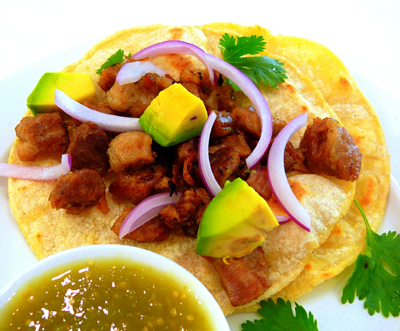 When ever I am asked what would my last meal be, the answer is always the same; a crispy taco. Crispy tacos are way at the top of my list of favorites and I have absolutely no will power when it comes to ordering in a Mexican restaurant. Intellectually, I know I should be ordering the soft tacos with grilled chicken or grilled shrimp in a Verde sauce. But I just can’t seem to help myself.
When ever I am asked what would my last meal be, the answer is always the same; a crispy taco. Crispy tacos are way at the top of my list of favorites and I have absolutely no will power when it comes to ordering in a Mexican restaurant. Intellectually, I know I should be ordering the soft tacos with grilled chicken or grilled shrimp in a Verde sauce. But I just can’t seem to help myself.
Growing up, a typical day was swimming at the Nathan’s pool, doing some arts and crafts, and then gathering up my friends and riding our bikes to Taco Tio. Taco Tio was a typical little taco stand about 3/4 of a mile from my house. Food was ordered through a sliding mesh screen and there were a few stools that sat under the outside, very high counter. I would order my crispy tacos, sit on those stools, and watch the lady make and assemble my afternoon snack. When Taco Tio closed and a sub shop tooks it place, it was a sad day in the neighborhood. And to this day, I have had a hard time replacing the taste of both their tacos or those memories.

 There is nothing like ordering fresh fish at a sea side tavern in Greece. It’s one of the quintessential experiences when visiting the Greek Isles. My friend Rich Campbell, who has uncanny knack for finding incredible places to eat, introduced me to a wonderful spot in Oia on Santorini called Taverna Katina in the quaint Ammoudi Port.
There is nothing like ordering fresh fish at a sea side tavern in Greece. It’s one of the quintessential experiences when visiting the Greek Isles. My friend Rich Campbell, who has uncanny knack for finding incredible places to eat, introduced me to a wonderful spot in Oia on Santorini called Taverna Katina in the quaint Ammoudi Port. In August 1997, and Jeff and I were at the Raleigh Farmers' Market in North Carolina. A farmer was selling a wide variety of chilies, including habaneros. I was instantly drawn to their shiny, reddish-orange skin and almost heart-like shape.
In August 1997, and Jeff and I were at the Raleigh Farmers' Market in North Carolina. A farmer was selling a wide variety of chilies, including habaneros. I was instantly drawn to their shiny, reddish-orange skin and almost heart-like shape. If I had to pick my favorite type of food, when it comes right down to it, it would have to be Mexican. I do enjoy so many types of food but the fresh flavors of the salsas, onions and avocado, homemade refried beans and I could just go on and on. I just love it.
If I had to pick my favorite type of food, when it comes right down to it, it would have to be Mexican. I do enjoy so many types of food but the fresh flavors of the salsas, onions and avocado, homemade refried beans and I could just go on and on. I just love it. If you ever visit a San Diego farmers' markets, then chances are you'll see several people milling around who are holding tall, clear plastic cups filled with deliciously ripe fresh fruit such as mangoes, pineapple, and watermelon that have been doused with lime juice, salt, and chili pepper. They may be eating the fruit with a long toothpick (or just with their hands, if they don't mind sticky fingers).
If you ever visit a San Diego farmers' markets, then chances are you'll see several people milling around who are holding tall, clear plastic cups filled with deliciously ripe fresh fruit such as mangoes, pineapple, and watermelon that have been doused with lime juice, salt, and chili pepper. They may be eating the fruit with a long toothpick (or just with their hands, if they don't mind sticky fingers).